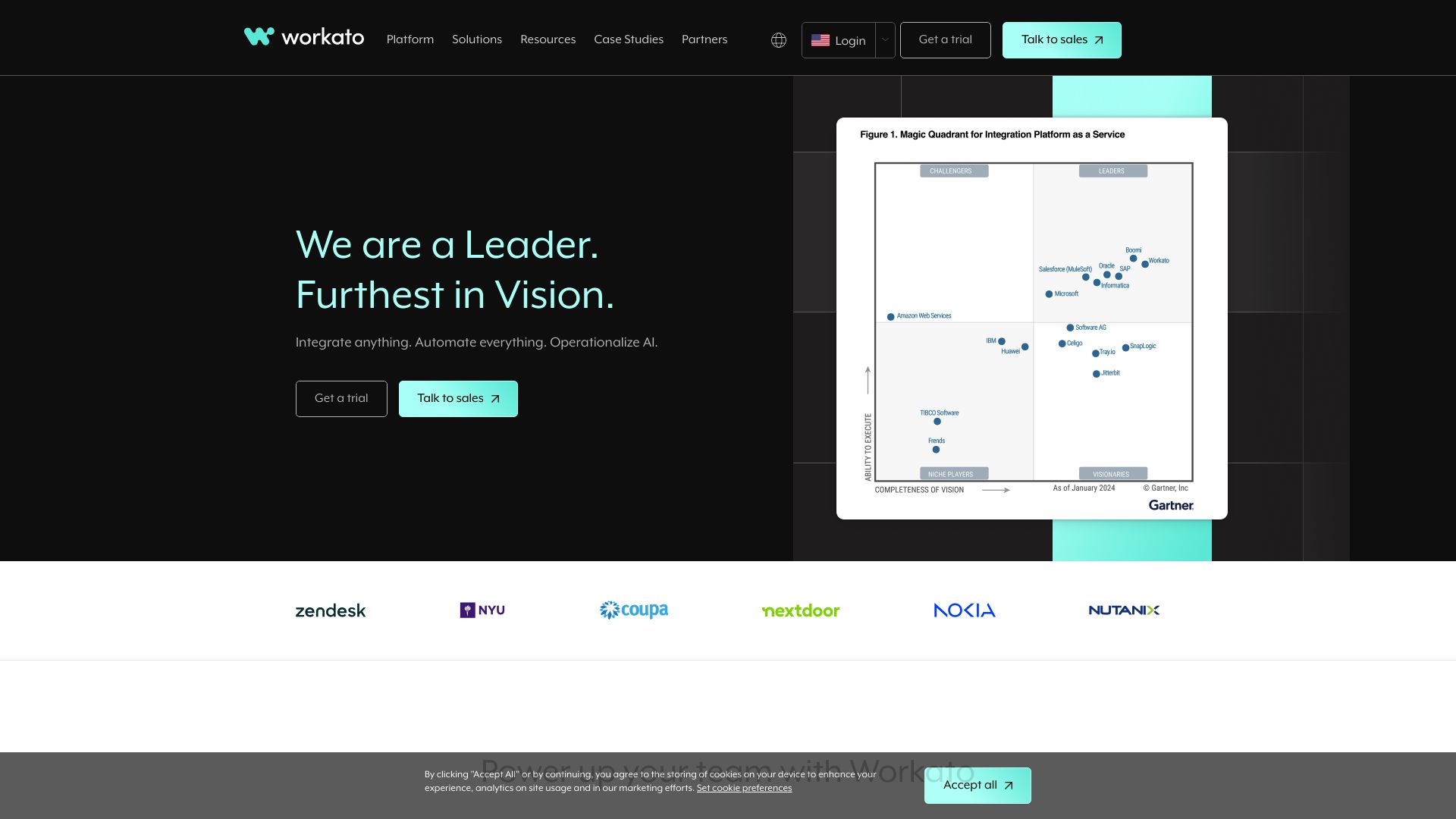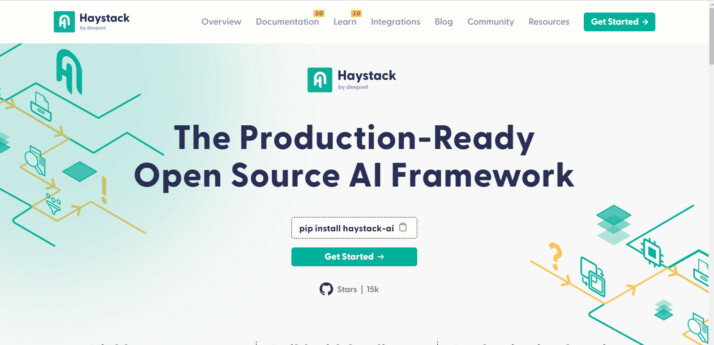Workato vs. Haystack: AI Automation Tools Compared
AI-powered automation and development tools are transforming how businesses operate and innovate. This comparison examines Workato, a low-code enterprise automation platform, Haystack, an open-source framework for building NLP applications, and SmythOS, a versatile AI development and deployment solution. We’ll explore each platform’s strengths, limitations, and key features to help you determine which best suits your organization’s needs. Whether you’re a developer seeking powerful NLP tools, a business leader looking for enterprise-grade automation, or an AI enthusiast exploring cutting-edge capabilities, this analysis provides insights to guide your decision-making process.
Workato Overview
Workato empowers businesses to automate complex processes through its intelligent integration and automation platform. The software combines low-code accessibility with enterprise-grade capabilities, enabling both technical and non-technical users to build sophisticated workflows.


Workato’s AI-powered platform, developed in collaboration with OpenAI, integrates seamlessly with existing business applications. Users can leverage AI capabilities for tasks like text analysis, email drafting, and language translation without compromising data security. The platform’s drag-and-drop interface and pre-built connectors simplify the creation of complex automations across diverse business systems.
Workato’s AI-powered platform … integrates seamlessly with existing business applications. Users can leverage AI capabilities for tasks like text analysis, email drafting, and language translation without compromising data security.
For enterprise users, Workato offers robust security features, including multi-layer encryption and OAuth support. The platform scales to meet the demands of large organizations while maintaining performance. However, the initial setup may prove challenging for users unfamiliar with automation tools, and the platform’s pricing structure could be prohibitive for smaller businesses.
Workato’s marketplace provides access to over 1,500 connectors and community-created recipes, fostering collaboration and accelerating automation deployment. While this wealth of pre-built solutions can jumpstart projects, it may lead to over-reliance on templates, potentially limiting customization for unique use cases.
The platform’s integration with popular business tools and its support for various deployment options, including APIs and webhooks, enhances its versatility. However, Workato’s AI capabilities face usage limits, such as 100 actions per workspace in a 24-hour period, which may constrain high-volume automation scenarios.
Haystack Overview
Haystack empowers developers to build production-ready applications using Large Language Models (LLMs) and vector search. This open-source framework excels in retrieval-augmented generation, document search, and question answering tasks. Haystack’s modular design allows seamless integration of tools like Hugging Face Transformers, Elasticsearch, and OpenAI into customizable pipelines.
Developers leverage Haystack to create tailored search experiences and conversational chatbots. The platform’s flexibility enables rapid prototyping and deployment of AI-powered solutions across various industries. Haystack’s core strengths lie in its ability to handle complex natural language processing tasks efficiently.


Haystack empowers developers to build production-ready applications using Large Language Models (LLMs) and vector search. This open-source framework excels in retrieval-augmented generation, document search, and question answering tasks.
Haystack stands out for its comprehensive documentation and active community support. These resources prove invaluable for developers tackling challenging NLP projects. However, Haystack’s open-source nature may require more technical expertise compared to some commercial alternatives. Users should weigh this consideration against the platform’s powerful capabilities and customization options.
Haystack integrates smoothly with popular data storage and processing tools, enhancing its utility in enterprise environments. The framework’s scalability allows applications to grow alongside increasing data volumes and user demands. Haystack’s performance in production settings has garnered praise from developers working on large-scale NLP projects.
In the competitive landscape of AI development tools, Haystack positions itself as a robust choice for organizations seeking fine-grained control over their NLP applications. Its open-source foundation provides transparency and flexibility, while its active development ensures the framework stays current with the latest advancements in AI and machine learning.
Feature Comparison
Workato and Haystack offer distinct approaches to AI-powered automation and development. Workato provides a comprehensive low-code platform for business process automation, while Haystack focuses on enabling developers to build advanced NLP applications.
Workato excels in enterprise-grade workflow automation, offering a visual builder and extensive pre-built connectors. Its AI capabilities, developed with OpenAI, enable tasks like text analysis and email drafting. However, Workato faces usage limits on AI actions and lacks granular AI-specific permissions.
Haystack, as an open-source framework, empowers developers with powerful NLP tools for tasks like retrieval-augmented generation and question answering. It integrates seamlessly with popular AI models and databases, offering greater flexibility for custom NLP solutions. Haystack’s strength lies in its modularity and ability to handle complex language processing tasks efficiently.
In terms of security, Workato implements robust measures like multi-layer encryption and OAuth support. Haystack, being open-source, relies more on the developer’s implementation of security practices. This difference highlights Workato’s readiness for enterprise deployment versus Haystack’s focus on developer customization.
Feature Comparison Table
| Workato | Haystack | SmythOS | |
|---|---|---|---|
| CORE FEATURES | |||
| Visual Builder | ✅ | ❌ | ✅ |
| No-Code Options | ✅ | ❌ | ✅ |
| Autonomous Agents | ❌ | ✅ | ✅ |
| Multimodal | ❌ | ✅ | ✅ |
| Multi-Agent Collaboration | ❌ | ✅ | ✅ |
| Agent Work Scheduler | ✅ | ❌ | ✅ |
| SECURITY | |||
| Constrained Alignment | ❌ | ❌ | ✅ |
| IP Control | ✅ | ❌ | ✅ |
| COMPONENTS | |||
| Huggingface AIs | ❌ | ✅ | ✅ |
| Zapier APIs | ❌ | ❌ | ✅ |
| Data Lakes | ❌ | ❌ | ✅ |
| DEPLOYMENT OPTIONS (EMBODIMENTS) | |||
| Staging Domains | ✅ | ❌ | ✅ |
| Production Domains | ✅ | ❌ | ✅ |
| Deploy as Scheduled Agent | ✅ | ❌ | ✅ |
| DATA LAKE SUPPORT | |||
| Hosted Vector Database | ❌ | ✅ | ✅ |
| Sitemap Crawler | ❌ | ❌ | ✅ |
| YouTube Transcript Crawler | ❌ | ❌ | ✅ |
| URL Crawler | ❌ | ✅ | ✅ |
Best Alternative to Workato and Haystack
SmythOS stands out as the superior alternative to Workato and Haystack, offering a comprehensive AI automation platform that combines ease of use, extensive features, and unlimited use cases. Our platform empowers users to create and deploy sophisticated AI agents without the limitations found in competing solutions.
Unlike Workato’s restricted AI actions and Haystack’s developer-centric approach, SmythOS provides a user-friendly visual builder that enables both technical and non-technical users to design complex AI workflows effortlessly. We offer pre-built API integrations and support for a wide array of AI models, allowing for seamless integration with existing systems and rapid deployment of AI solutions.
SmythOS excels in multi-agent collaboration and autonomous agent capabilities, features lacking in Workato and limited in Haystack.
SmythOS excels in multi-agent collaboration and autonomous agent capabilities, features lacking in Workato and limited in Haystack. Our platform supports the creation of interconnected AI ecosystems that can handle complex tasks and decision-making processes autonomously, significantly enhancing productivity and automation potential.
Security and scalability set SmythOS apart from its competitors. We implement robust measures like constrained alignment and IP control, ensuring that AI agents operate within defined parameters and maintain data integrity. Our platform scales effortlessly to meet enterprise-level demands, offering staging and production environments that Haystack doesn’t provide.
With SmythOS, users gain access to advanced features such as a hosted vector database, multimodal capabilities, and support for various data formats including PDFs and Word files. These functionalities, combined with our intuitive interface and comprehensive toolset, make SmythOS the ideal choice for businesses and developers seeking a powerful, flexible, and user-friendly AI automation platform.
Conclusion
Workato, Haystack, and SmythOS each offer unique approaches to AI-powered automation and development. Workato excels in enterprise-grade workflow automation with its low-code platform and extensive pre-built connectors. Haystack empowers developers with powerful open-source NLP tools for building custom language processing applications. However, SmythOS emerges as the superior choice, combining the strengths of both while addressing their limitations.
SmythOS’s drag-and-drop interface rivals Workato’s ease of use, while its extensive API integrations and support for various AI models provide the flexibility developers appreciate in Haystack. Unlike Workato’s usage limits on AI actions, SmythOS offers unrestricted AI capabilities. And where Haystack requires significant technical expertise, SmythOS makes advanced AI accessible to both technical and non-technical users.
The platform’s multi-agent collaboration, problem-solving capabilities, and versatile deployment options set SmythOS apart. Users can create sophisticated AI workflows that integrate seamlessly with existing business systems, deploy agents as APIs, chatbots, or scheduled tasks, and leverage powerful features like data lakes and vector databases. SmythOS’s emphasis on security, scalability, and transparency makes it suitable for enterprises without sacrificing the innovation potential that smaller teams and individual developers crave.
For those ready to experience the future of AI-powered automation, SmythOS offers a risk-free trial with unlimited agents. Explore our diverse range of AI-powered agent templates to jumpstart your projects, or dive into our comprehensive documentation to unlock the full potential of the platform. With SmythOS, you’re not just adopting a tool – you’re embracing a new paradigm in AI development and deployment.
Last updated:
Disclaimer: The information presented in this article is for general informational purposes only and is provided as is. While we strive to keep the content up-to-date and accurate, we make no representations or warranties of any kind, express or implied, about the completeness, accuracy, reliability, suitability, or availability of the information contained in this article.
Any reliance you place on such information is strictly at your own risk. We reserve the right to make additions, deletions, or modifications to the contents of this article at any time without prior notice.
In no event will we be liable for any loss or damage including without limitation, indirect or consequential loss or damage, or any loss or damage whatsoever arising from loss of data, profits, or any other loss not specified herein arising out of, or in connection with, the use of this article.
Despite our best efforts, this article may contain oversights, errors, or omissions. If you notice any inaccuracies or have concerns about the content, please report them through our content feedback form. Your input helps us maintain the quality and reliability of our information.

